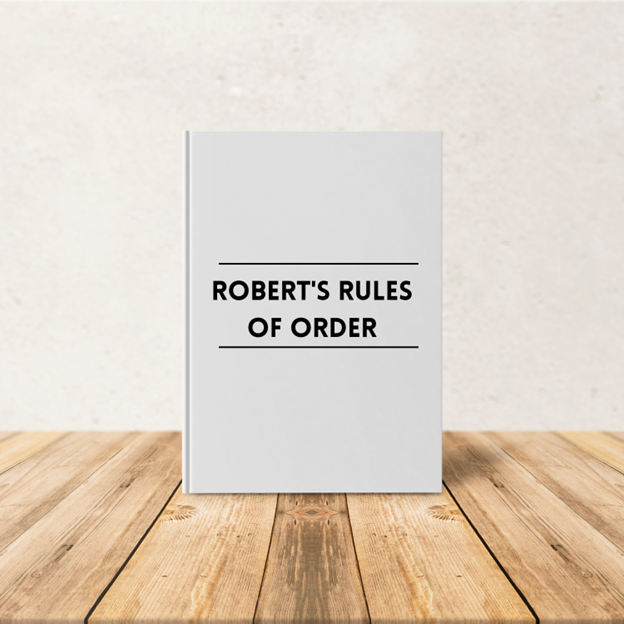Maintaining order and fairness in meetings is crucial when managing a homeowner's association (HOA). Robert’s Rules of Order provides a structured framework to ensure that all board members have a voice and that decisions are made efficiently. This article will explore Robert’s Rules, their origins, and how they can be applied to board meetings.
What are Robert’s Rules of Order?
Robert’s Rules of Order is a manual of parliamentary procedure that governs the conduct of meetings. It was established by Henry Martyn Robert, an American military officer, in 1876. He aimed to create a standardized set of procedures to ensure meetings were fair, orderly, and efficient. Today, Robert’s Rules are widely used by various organizations, including community associations, to facilitate smooth and democratic decision-making processes.
While some associations may be required by their bylaws to adhere to Robert's Rules for meetings, it's a good practice to use them as a guide for creating meeting rules, even if not mandated. If your bylaws state that “meetings shall be run according to Robert’s Rules of Order Newly Revised, latest edition,” and your board has 12 or fewer members, you are fully entitled to use Robert’s rules for small boards. In these 'informal meetings,' the rules are less formal than those for larger bodies. The person presiding is usually seated and can make, discuss, and vote on motions.
Key Principles of Robert’s Rules
- Equal Rights for All Members
One core tenet of Robert’s Rules is that all board members have equal rights. Regardless of their position, each member should be treated equally and fairly. This principle ensures that no single member has undue influence over the board’s decisions. - Maintaining Focus
Robert’s Rules emphasize the importance of maintaining a clear focus to keep meetings productive. Only one motion should be discussed at a time, ensuring that debates remain relevant to the topic at hand. - Orderly Debate
Debates should be conducted in an orderly manner. Just as only one motion should be discussed at a time, only one person should speak at a time. This approach helps keep the agenda on track and ensures that discussions are focused and efficient. - Respectful Conduct
Respectful conduct is crucial in board meetings. Members should avoid personal attacks and focus on the facts. This atmosphere fosters a productive and cooperative environment that facilitates reaching consensus, even if there is no agreement. - Majority Rules
Decisions generally follow the majority ruling unless otherwise stated in the governing documents. This democratic approach ensures that the board’s actions reflect the will of most members, promoting fairness and transparency.
Types of Motions in Robert’s Rules
Understanding the different types of motions is essential for effective participation in meetings. When making a motion, summarize what is being proposed so there can be no confusion later. For example, when moving to approve a contract proposal, include the service provider's name, the amount being voted on, and the scope of work that will be carried out. Include dates for the contract term and timelines for executing the work. This information is recorded in the minutes – only the facts, not the discussion.
Here are the motions most commonly used in smaller meetings (e.g., board or committee meetings):
- Motion to Introduce
A member makes a motion to propose an action or decision. Another member must second the motion. After this, the group votes on the motion. It passes by a majority vote or quorum – check your bylaws to determine how motions are passed. - Motion to Adopt
A motion to adopt proposes that members accept a decision. This motion is the final step in approving a proposal after thoroughly discussing it. It is crucial for formalizing decisions and moving forward with actions. - Motion to Amend
If members wish to change a motion currently under discussion, they can use a motion to amend it. This allows modifications to be considered, ensuring that the final decision is well-thought-out and beneficial for the community. - Motion to Adjourn
This is a motion to end the meeting. A member must make the motion, which another member must second. If the majority votes to end the meeting, it’s officially over. - Motion to Table
A motion to table is used when members want to postpone the discussion of a particular issue. This can be helpful if more information is needed or the board needs more time to consider the matter. Tabling an issue ensures that it will be revisited later.
Conclusion
Robert’s Rules of Order is an invaluable tool for HOA board and committee meetings, providing a structured and democratic framework for decision-making. By adhering to these rules, boards can ensure that all members are treated equally, debates remain focused and orderly, and decisions reflect the majority’s will. Understanding and implementing the various types of motions can further enhance the efficiency and effectiveness of board meetings, respect the time spent by volunteer board members, and ultimately benefit the entire community.
Familiarizing themselves with Robert’s Rules can lead to more productive meetings and better governance for community management companies and board members. By following these guidelines, board members can create a fair and respectful environment where all voices are heard, and decisions are made in the community's best interest.


